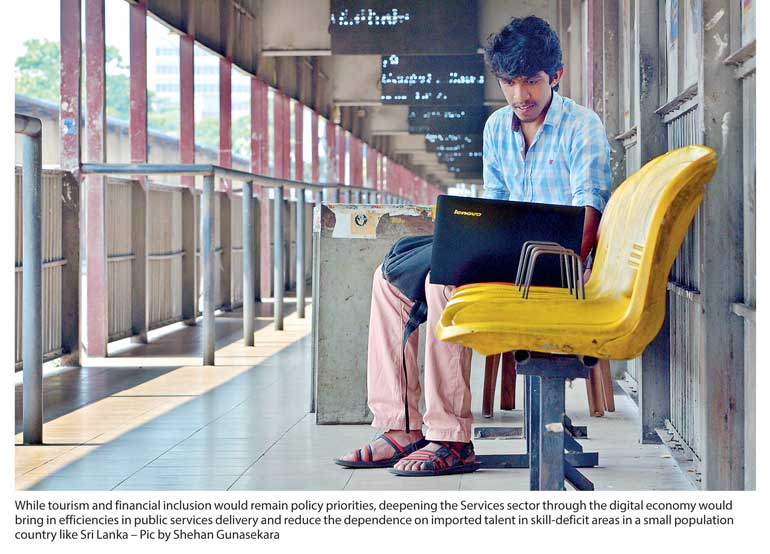Friday Mar 14, 2025
Friday Mar 14, 2025
Friday, 9 March 2018 00:00 - - {{hitsCtrl.values.hits}}

 Sri Lanka is at an interesting juncture. The Sirisena Government is halfway through its term, yet economic growth has been muted in recent years. It is imperative to draw up a blueprint for economic revival at the earliest.
Sri Lanka is at an interesting juncture. The Sirisena Government is halfway through its term, yet economic growth has been muted in recent years. It is imperative to draw up a blueprint for economic revival at the earliest.
If Sri Lanka wants to grow its economy from the current ~$ 84 billion to $200 billion by 2025, it would have to grow at a stellar 12% CAGR. That may sound daunting, but many nations like China, Malaysia, etc. achieved decadal double-digit growth in the initial years of their journey. A high, yet achievable, target pushes the commitment from politicians to realise the economic agenda.
Even India’s Maharashtra state announced a vision to grow its economy by 15% CAGR to reach $ 1 trillion. But to what extent should Sri Lanka focus on each growth-driver to realise this target of $ 200 billion?
If the proportion of each growth-driver has to move closer to the average proportions seen in rapidly growing emerging markets, that can indicate by how much they should grow in Sri Lanka. This is what we explore here.
Let us start with the Services sector: ~60% of Sri Lankan GDP is estimated to come from services; mainly tourism and BFSI. The average in most emerging markets has been ~60-70%. If Services have to make up~65% of Sri Lankan GDP by 2025, it would have to grow at a 12% CAGR, in line with the 12% estimated GDP growth.
While tourism and financial inclusion would remain policy priorities, deepening the Services sector through the digital economy would bring in efficiencies in public services delivery and reduce the dependence on imported talent in skill-deficit areas in a small population country like Sri Lanka. It would also ensure delivery of subsidies to the intended recipients, like India’s Direct Benefit Transfer.
Services also include ramping up the quality of skill-centres like India’s NSDC, to improve productivity and employment. All these would expand its addressable consumer base and purchasing power.
Let us move to industry: ~31% of Sri Lankan GDP is estimated to come from industry, in line with the average ~30% seen in large emerging markets. So if its industry has hold itself at this 30-35% proportion, it would have to grow at 11% CAGR.
Sri Lanka’s gross investment was ~30-35% of GDP in recent years, a bit less than the ~35-40% seen in China and Malaysia in their initial years of industrialisation. If Sri Lanka intends to push this towards ~40% in order to drive capacity addition, its investment has to grow at a 15% CAGR, higher than the estimated GDP growth.
Investment also correlates with productive imports like machinery. In Sri Lanka, import comprised ~30% of GDP, in line with the share of investment. But recent industrialising nations have seen that their share of imports to be ~50-60% of their share of investment. This means part of Sri Lanka’s imports may have been for non-productive purposes. That has to reduce. So if import grows at only 8% CAGR, its share can dip to 24% of GDP by 2025 (i.e. 60% of the share of investment, estimated at 40% of GDP).
Where should investments go? Housing, transport and urban infrastructure apart, there is a need for economic corridors that would connect commercial zones with the underdeveloped regions. New industry clusters have to focus on hinterlands for inclusive growth across districts.
Electric vehicle manufacturing, a focus-area in India, can reduce oil import dependence. But this would also mean addressing the Ease of Doing Business parameters, where it lost its rank by 26 places since 2014.
Coming to agriculture: ~8% of Sri Lankan GDP is estimated to come from agriculture, in line with the sub-10% share seen in most large emerging markets. But the crux is to improve farm productivity, as agriculture employs ~27% of Sri Lanka’s workforce.
If its share of agriculture has to hold at 5-8%, it would grow at a 5% CAGR. But this growth has to be backed by productivity improvement. For this, it has re-skill unproductive labour for high-growth sectors like construction, tourism and retail. That would mean investing in skill-training, like India’s NSDC.
It also means investing in irrigation, power and market linkages to improve acreage yield and ensure the end-farmer gets the correct market price. So part of the incremental gross investment also has to flow into the agro-sector.
Moving to export: Only ~20% of Sri Lankan GDP is estimated to come from exports. Its export has to grow at a rapid 13% CAGR in line with estimated GDP, if it has to meet the forex demand for imports and keep trade imbalance nil.
The issue is that the LKR lost competitiveness as the BDT or PKR dropped more last year, hence export of common products like textile and food may not be supportive. This makes it all the more imperative to draw up Free Trade Agreements and export-promotion schemes with partner countries to open further export opportunities.
Last, where would investments be funded from? Sri Lanka has a slightly higher share of private consumption to GDP – 68% vs. the ~60% seen in large emerging markets. Indonesia and South Africa have a similar per-capita, but they spend less and save more.
Over-dependence on external borrowing is not healthy, as it has exchange-rate and collateral implications. It needs to ramp up its savings rate from ~27% to 30%+ by energising its domestic financial sector with more products and regulations. That would incentivise more saving and postponing consumption.
All in all, these segmental growth rate estimates to target a GDP of $200 billion by 2025 may sound over-ambitious. But it is not unachievable, if one looks at similar markets.
(The writer is an author, financial services professional, and researches for South Asia Fast Track.)
Discover Kapruka, the leading online shopping platform in Sri Lanka, where you can conveniently send Gifts and Flowers to your loved ones for any event including Valentine ’s Day. Explore a wide range of popular Shopping Categories on Kapruka, including Toys, Groceries, Electronics, Birthday Cakes, Fruits, Chocolates, Flower Bouquets, Clothing, Watches, Lingerie, Gift Sets and Jewellery. Also if you’re interested in selling with Kapruka, Partner Central by Kapruka is the best solution to start with. Moreover, through Kapruka Global Shop, you can also enjoy the convenience of purchasing products from renowned platforms like Amazon and eBay and have them delivered to Sri Lanka.
Discover Kapruka, the leading online shopping platform in Sri Lanka, where you can conveniently send Gifts and Flowers to your loved ones for any event including Valentine ’s Day. Explore a wide range of popular Shopping Categories on Kapruka, including Toys, Groceries, Electronics, Birthday Cakes, Fruits, Chocolates, Flower Bouquets, Clothing, Watches, Lingerie, Gift Sets and Jewellery. Also if you’re interested in selling with Kapruka, Partner Central by Kapruka is the best solution to start with. Moreover, through Kapruka Global Shop, you can also enjoy the convenience of purchasing products from renowned platforms like Amazon and eBay and have them delivered to Sri Lanka.